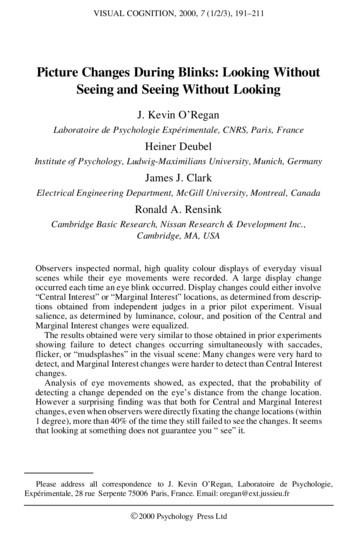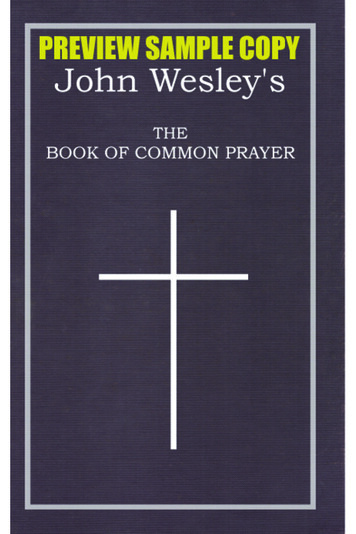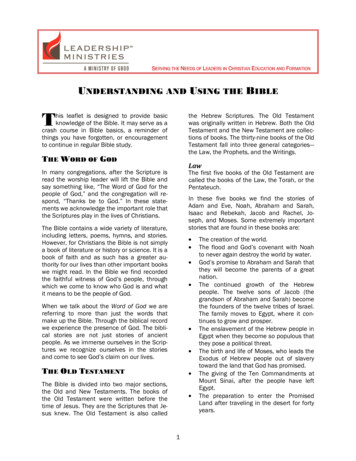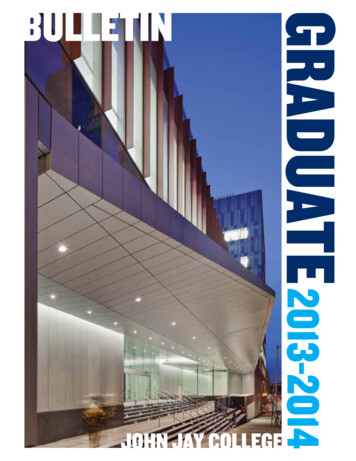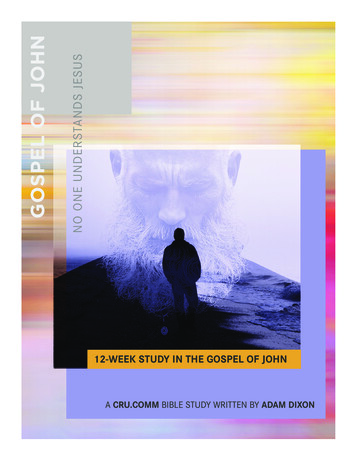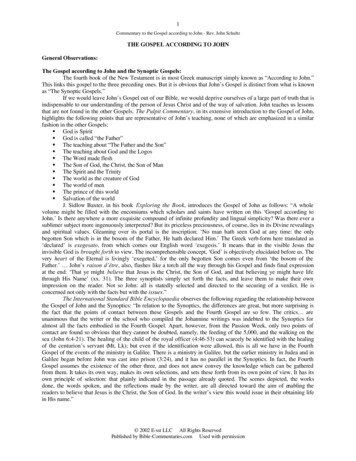
Transcription
SEEING AMERICA: John Koch’s Interlude, 1963Artists’ works reflect the values of their times as well as their own points ofview.John Koch (1909 –1978)Interlude, 1963Oil on canvasGift of Mr. and Mrs. Thomas H. Hawks, 65.12Collection of the Memorial Art Gallery of theUniversity of RochesterCourtesy Kraushaar Galleries, New YorkThe Art“I am intensely concerned with the believability of my painted world.Again and again I invent objects, people, and even places that do notexist.” (Seeing America, 275)Interlude reminds the viewer that the long history of representational art—portraiture, genre painting, and still life—continues to flourish in America.The story of artist and model is an old and traditional art theme. Here artistJohn Koch presents a moment in his studio when both artist and model relax, the nude model to enjoy a cup of tea while the artist gazes at his partiallycompleted work on the easel. The African American model dominates theforeground as Koch sets her dark velvety back against the white bed sheetand the vibrant red robe of the third person in the painting, a white womanwho offers a cup of tea. As Koch draws the viewer deeper into the room,the curved lines of the model’s body are repeated in the Queen Anne chair,glass pitcher, teapot and doorway arch. Contrast these curving lines with thediagonal lines on the painting’s right side.There the receding floorboards, thelong legs of the lounging artist, and the angle of the easel create the believClassroom Guide: Seeing America Through Artists’ Eyes1
able space of the studio. The circles of light accenting the artist in the background help the muted tones on the right balance the powerful push-pull ofthe colors on the left.Koch’s compositional skills and ingenuity are evident in his placement of thelarge rectangular mirror behind the couch. What the viewer imagines at firstas windows in the painting’s background are revealed to be the reflection ofthe room behind the model. Also striking is that the three figures neither engage with the viewer, nor do they engage in eye contact with each other. Themodel’s dramatically foreshortened arm reaches back to the older woman,but she does not touch the teacup; neither does the robed white womanlook directly at the naked young black model.Glossaryforeshortening: Technique used in perspectiveto create an illusion of an object receding into thebackground.Believable scene of art and model: yes. Every inch of the painting is “photographically” correct—the three-dimensionality of the room, the gleam of thehighly polished floor, the accurate details of the gooseneck lamp and other decade-appropriate objects. The apartment/studio, and the two women(Koch’s wife, Dora, and the model, Rosetta Howard) appear in many JohnKoch paintings. Yet he admits to “staging” his scenes—and leaves the viewerto imagine his purpose.Is Interlude simply a portrayal of a relaxing break in the process of painting?Or does it also gesture toward some of the social changes of 1963, theyear it was painted? Consider, for instance, the implications of the multiplereversals—the windows revealed to be reflections, and, at the center, a whitewoman serving a woman of color.The Artist65173718461852186518761807 09 1119 19 1923192819391942194819631978199819Koch diesJohn Koch born inToledo, OhioJohn Koch (1909–1978) was born in Toledo, Ohio, and spent much of hischildhood in Ann Arbor, Michigan. He taught himself to paint by copying theold masters at the Louvre during the five years (1928–33) he lived in Paris.Upon his return from Europe, he moved to New York City, determined topaint the people and places he saw there.Koch was interested in portraying the sophisticated community he livedamong—painters, models, and musicians like his wife, Dora Zaslavsky, aprominent piano teacher at the Manhattan School of Music. Koch oftenpainted himself at work in his studio in his Central Park West apartment inthe El Dorado. His was a self-contained elegant world high above the busycity streets.John Koch had a very successful career painting commissioned portraits ofprominent New Yorkers. He worked very methodically: a sketch to workClassroom Guide: Seeing America Through Artists’ EyesEdward SudentasThe Eldorado, Art Deco Coop2
out the composition, then sketches from life, which he then enlarged andtraced onto the canvas, and finally the painted version. Often the subjectswere sketched separately and never met each other.Koch recorded the objects of his life—his apartment rooms, the views outside his windows, his chairs, lamps and especially the mirrors. The apartmentor other settings were like a stage set, with the props of a private, gracious,well-ordered life. He painted these objects as if they were still lifes—withtextures and lustrous surfaces. He moved the objects, even the doorways,to satisfy his compositional strategy. Much of the life he portrayed neverhappened—except in his mind. Reality as it should be!Koch was undeterred by abstraction’s dominance in the art world during the1940s-1960s. An exhibition in 2001, John Koch: Painting a New York Life, reestablished his significance during these decades as a supremely talented artistwho worked successfully in parallel with the prevailing style of his time.John Koch (1909 – 1978)The Lesson, 1970The New York Historical SocietyAmericaMichael Harrington publishesThe Other AmericaU. S. Air Force veteran JamesMeredith becomes the firstAfrican American student at theUniversity of Mississippi6219Beatles arrive in the U. S.Dr. Martin Luther King, Jr.is assassinated in Memphis,TennesseePresident Lyndon B. Johnsondeclares War on Poverty6319Betty Friedan publishesThe Feminine Mystique6419696865191919Watts Riots in Los AngelesWoodstock FestivalMarch on Washington for Jobsand FreedomPresident John F. Kennedyassassinated in Dallas, TXIn 1963, Bob Dylan released his new album, The Times They Are A-Changin, withmusic that captured the social issues and conflicts of the decade: racial tension, economic inequality, and the generation gap. In America, the post-WorldWar II years were a time of great economic growth and personal wealth;families bought their own homes and cars; television reached almost 90 percent of American homes by 1963; credit cards and installment plans fueledconsumption. Numerous educational opportunities allowed many Americansto move into the middle class.But the widespread prosperity of postwar America did not reach everyone.In The Other America: Poverty in the United States (1962), Michael Harringtonwrote that nearly 20 percent of Americans lived below the poverty line. Manylived in the new urban slums; between 1945 and 1960, nearly five million African Americans had moved from the rural South to cities in the North as wellas to Atlanta and Washington, DC.This large-scale migration to the cities hadfueled rising expectations—and a civil rights movement. However, as middleclass whites left the city for the suburbs, urban schools, housing, and publicfacilities deteriorated and urban job opportunities declined.Classroom Guide: Seeing America Through Artists’ EyesUnknown photographerA young civil rights demonstrator at theMarch on Washington for Jobs and Freedom,August 28, 1963National Archives and Records Administration306-SSM-4B-61-323
1963 was a year of momentous events in America. Protests against racial discrimination led to violence Americans could watch on the television nightlynews as Bull Connor used fire hoses, electric cattle prods, and police dogsagainst black demonstrators in Birmingham, Alabama. Martin Luther King, Jr.,wrote his important “Letter from Birmingham Jail” arguing that individualshave the moral duty to disobey unjust laws. In June, President John F. Kennedyproposed a Civil Rights Bill. A day later, NAACP field secretary Medgar Everswas murdered outside his home. In August, about 200,000 people heard Martin Luther King, Jr. deliver his “I Have a Dream” speech during the March onWashington. A month later, four young girls died when a bomb exploded attheir Birmingham, Alabama, church on a Sunday morning. On November 23,President Kennedy was assassinated.Cold War fears, civil rights demonstrations, and the Vietnam War led many—especially young people—to question the values of American society. Students demanded free speech and assembly; attendance at traditional churches plummeted as people sought spiritual answers in eastern religions; popartists like Andy Warhol and rock musicians like the Beatles challenged traditional art and music standards. The generation gap widened as many youngpeople felt something deeply amiss in the United States, while older Americans remembered the past struggles and urged more faith in the governmentand American political, social, and religious institutions.The pace and depth ofthese social, political, and economic changes was challenging for many Americans, but their impact has had a profound and lasting effect on the country.See also Susan Dodge-Peters Daiss,“John Koch: Interlude (1963),” in Marjorie B. Searl, ed., SeeingAmerica: Painting and Sculpture from the Collection of the Memorial Art Gallery of the University ofRochester (Rochester, NY: University of Rochester Press, 2006), 275–77.Classroom Guide: Seeing America Through Artists’ Eyes4
Classroom Activities: Seeing America Through Artists’ EyesObserving DetailWhat clues in the painting tell you where and when this is?How does knowing the title, Interlude, shape the meaning in this painting?What questions would you ask the artist?Comparing and ContrastingWhile accurately recording the objects of his life, John Koch manipulated the settings to create pleasing compositions and theappearance of a gracious, well-ordered life. Compare the painting with the preparatory studies. What artistic decisions hasKoch made? What is the result of these decisions?John Koch (1909 –1978)John Koch (1909 –1978)John Koch (1909 –1978)Interlude, 1963Study for “Interlude” (I), 1963Study for “Interlude” (II), 1963Oil on canvasGraphite on paperGraphite on paperGift of Mr. and Mrs. Thomas H. Hawks, 65.12Gift of the artist, 65.63.1Gift of the artist, 65.63.2Collection of the Memorial Art Gallery of theCollection of the Memorial Art Gallery of theCollection of the Memorial Art Gallery of theUniversity of RochesterUniversity of RochesterUniversity of RochesterCourtesy Kraushaar Galleries, New YorkCourtesy Kraushaar Galleries, New YorkCourtesy Kraushaar Galleries, New YorkClassroom Guide: Seeing America Through Artists’ Eyes5
Finding and Analyzing Point of ViewWomen’s lives have been popular subject matter in American art. Compare these paintings of American women. Considertime periods, life styles, social class as well as the personalities revealed through facial expression, gesture and body language.Ammi Phillips (1788 – 1865)Lilly Martin Spencer (1822 – 1902)Old Woman with a Bible, ca. 1834Peeling Onions, ca. 1852Oil on linenOil on canvasBeatrice M. Padelford Trust, 84.22Gift of the Women’s Council in celebration of the 75th anniversary of theCollection of the Memorial Art Gallery of the University of RochesterMemorial Art Gallery, 88.6Collection of the Memorial Art Gallery of the University of RochesterKathleen McEnery Cunningham (1885 – 1971)John Koch (1909 –1978)Woman in an Ermine Collar, 1909Interlude, 1963Oil on canvasOil on canvasGift of Joan Cunningham Williams, Peter Cunningham, and Michael McEneryGift of Mr. and Mrs. Thomas H. Hawks, 65.12Cunningham, 83.13Collection of the Memorial Art Gallery of the University of RochesterCollection of the Memorial Art Gallery of the University of RochesterCourtesy Kraushaar Galleries, New YorkClassroom Guide: Seeing America Through Artists’ Eyes6
Reading and Interpreting Visual LanguageHow and why do artists create realistic interior places? What details do the artists include and what is the effect achieved?Compare the settings created by the artists of these paintings.M. M. Manchester (active ca. 1840)Lilly Martin Spencer (1822 – 1902)Judge and Mrs. Arthur Yates, ca. 1840Peeling Onions, ca. 1852Oil on canvasOil on canvasGallery Purchase, 41.30Gift of the Women’s Council in celebration of the 75thCollection of the Memorial Art Gallery of the University of Rochesteranniversary of the Memorial Art Gallery, 88.6Collection of the Memorial Art Gallery of theUniversity of RochesterMortimer Smith (1840 – 1896)John Koch (1909 –1978)Home Late, 1866Interlude, 1963Oil on canvasOil on canvasMarion Stratton Gould Fund, 75.139Gift of Mr. and Mrs. Thomas H. Hawks, 65.12Collection of the Memorial Art Gallery of theCollection of the Memorial Art Gallery of theUniversity of RochesterUniversity of RochesterCourtesy Kraushaar Galleries, New YorkClassroom Guide: Seeing America Through Artists’ Eyes7
Exploring the ContextArtists are keen observers and commentators on the world in which they live. Use The Artist and America timelines to consider the effect of American history and art history as reflected in their artwork. In what ways did the artist capture or reflectthe events, mood and/or values of his/her America? In what ways did the artist continue or alter the American art traditionshe/she would have seen?Reading and Interpreting Visual LanguageJohn Koch is remembered as saying, “I am quite visibly a realist, occupied essentially with human beings, the environments theycreate, and their relationships.” How does the artist accomplish this goal in Interlude?We are grateful for the generous support of this project from the Anne and Vincent DeClue family and our SchoolProgram sponsors: Dominion, Bank of America, the Mary W. Clark Trust and two anonymous donors. Additional support is provided by Thomson Reuters, the Chester and Dorris Carlson Charitable Trust, Mr. and Mrs. Thomas F. Judson Jr.,Rochester Gas and Electric Corporation, Hammer Packaging, the estate of Estelle B. Goldman and an anonymous donorfor the McPherson Director of Education.Classroom Guide: Seeing America Through Artists’ Eyes8
foreground as Koch sets her dark velvety back against the white bed sheet and the vibrant red robe of the third person in the painting, a white woman who offers a cup of tea. As Koch draws the viewer deeper into the room, the curved lines of the model’s body are repeated in the

